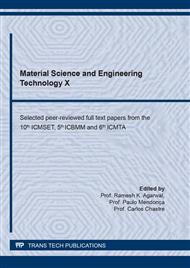p.71
p.77
p.85
p.91
p.98
p.104
p.109
p.119
p.125
Poly(L-Lactide) Membrane as an Elastic Membrane to Support Cardiac Bleeding Intervention
Abstract:
Cardiac bleeding is one of the postoperative complications which gives a negative prognostic implication following a heart surgery. Safety measurements are being taken to resolve cardiac bleeding yet unexpected bleeding is unpredictable. Polymer membranes/scaffolds have been developed to overcome this issue. The utilization of poly (L-lactic acid) (PLLA) as a biodegradable and biocompatible polymer, representing a promising approach to serve as a cardiac membrane in covering cardiac bleeding. In the present work, PLLA membranes were fabricated through a solvent-evaporation casting technique at various concentration of 0.01, 0.03, 0.05 and 0.07 g/mL PLLA. The membranes were observed through an inverted microscope and the tensile properties were determined using a texture analyzer. All membranes were viewed in an approximately general similar structure. The 0.07 g/mL PLLA membrane exhibited Young’s modulus of 1480.89 ± 47.80 kPa, and stiffness of about 20.19 ± 0.65 kPa, which is suitable to be used as a cardiac membrane due to its approaching mechanical properties towards the cardiac membrane at its maximum contraction. In future, the PLLA membrane could be incorporated with other bioactive and therapeutic materials to improve its biological properties for cardiac application.
Info:
Periodical:
Pages:
98-103
Citation:
Online since:
February 2022
Authors:
Keywords:
Price:
Сopyright:
© 2022 Trans Tech Publications Ltd. All Rights Reserved
Share:
Citation:


